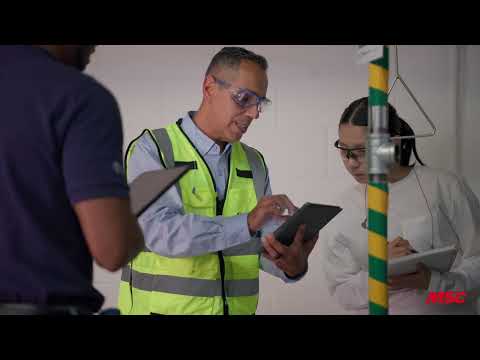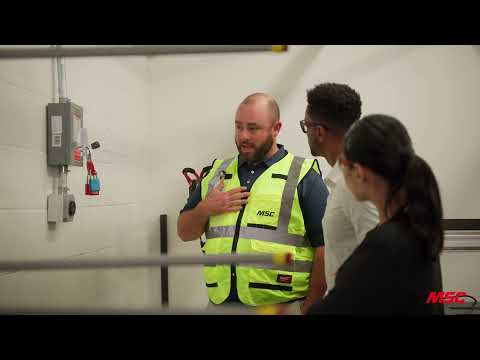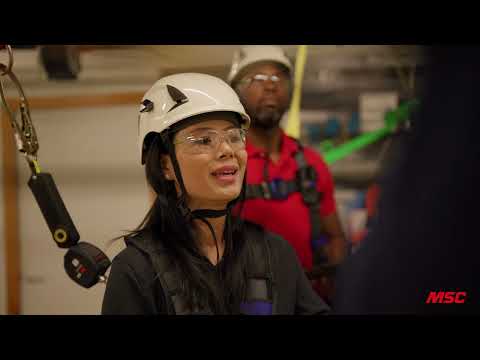An ounce of prevention is worth a pound of cure, Benjamin Franklin told Philadelphia newspaper readers when he recommended setting up the city’s first fire department after an early 18th-century blaze gutted a riverside wharf, then spread to nearby homes.
More than 200 years later, it’s still a sound principle, one that’s reflected both in federal workplace safety regulations and industry best practices including regular safety assessments like those provided by MSC’s team of industrial safety consultants.
The value-added service “can show you what you stand to gain by raising your safety standards,” MSC says. “Whether your goals are as straightforward as updating PPE or as involved as overhauling your entire safety culture, we can provide actionable insights that keep your workforce safe, decrease absenteeism, drive increases in output and improve overall productivity.”
Identifying workplace hazards is a critical first step to protecting employees, helping to ensure they return home safely at the end of their shifts, as well as to meeting—and exceeding regulatory requirements, safety professionals say.
Too often, workplace safety strategies are reactive, according to the U.S. Occupational Safety and Health Administration, the nation’s top workplace safety regulator. Companies take action only after a worker is injured or becomes sick, a new regulation is enacted or a regulatory inspection uncovers a problem.
OSHA recommends taking the opposite tack.
“Finding and fixing hazards before they cause injury or illness is a far more effective approach,” the agency says. “Doing so avoids the direct and indirect costs of worker injuries and illnesses and promotes a positive work environment.”
In 2021, the costs of injuries and illnesses totaled $167 billion, the National Safety Council estimates, including 103 million lost workdays. Fatal workplace injuries spiked 9 percent to 5,190 in that time frame, according to government statistics, even as nonfatal workplace injuries declined slightly.
Offering safety training and assessments that can help businesses avoid such consequences helps to differentiate MSC from competitors, since customers facing growing pressure to make workplaces safer increasingly seek valued-added services when making major purchases.
Next--Level Safety: Adding Best Practices
The pressure comes not just from OSHA, but from environmental, safety and governance advocates, including stockholders, as well as insurers, explains Jeffrey Merkel, who manages MSC’s industrial safety consultants team.
Its members carry accreditations including Qualified Safety Sales Professional (QSSP), OSHA 30-hour training and Certified Safety Professional (CSP), equipping them to provide a broad-scope safety analysis.
“We walk through the entire facility with the customer,” identifying hazards and risks throughout, Merkel says. “An even more important piece is that we then help them find the solutions to mitigate those problems.”
Many customers learn about the safety consultants after contacting MSC to purchase safety gear from lockout/tagout devices to first-aid supplies and personal protective equipment, or PPE.
“Customers may be thinking only of glasses and gloves, but when we show them how much more we have to offer, they say, ‘Absolutely. Come take a walk through our facility and show us what you can do here,’” Merkel adds.
The fundamental basis for the analysis is the general duty clause of the law creating OSHA, which requires employers to provide a hazard-free workplace, and agency standard 1910, which includes broadly applicable regulations covering fall protection equipment, hazardous materials management and personal safety gear.
“We then go above and beyond that to offer recommendations based on best practices from our own experience,” Merkel explains.
Want to make your workplace safer? Click here to request an MSC safety assessment.
One example is OSHA’s requirement that companies handling corrosive materials supply eye washes and safety showers for employees. While the rule doesn’t specify water-flow requirements for the installations, MSC consultants can refer to detailed guidelines from the industry-led American National Standards Institute, or ANSI.
“We’re looking at risk overall, so even if something is in compliance—following the letter of what OSHA says—if there’s still a good chance that someone could get hurt as a result, we’ll note it and make a recommendation on how to make it safer,” Merkel says.
As demand for the service increases, growing 77 percent in the past year alone, MSC is expanding the areas in which it’s offered.
Along with the assessments, MSC works with supplier partners to arrange fee-based training on topics from lockout/tagout to fall protection and electrical safety designed to comply with regulatory requirements.
Arc Flashes and Electrical Safety
Electrical hazards such as arc flashes are major concerns in industries like manufacturing and construction, but MSC notes they often occur in other occupations that haven’t typically received extensive training.
To bridge that gap, MSC teams with Martin Technical, which employs experts from electrical engineers to field technicians and testing and reliability engineers.
Lockout/Tagout
One key part of protecting employees from hazardous energy is establishing a lockout/tagout system, a practice required under OSHA standard 1910.147, to ensure that electrical equipment remains powered off while maintenance work is performed.
As many as 120 fatalities a year and 50,000 injuries could be prevented with the correct use of lockout/tagout systems, MSC says, and the average penalty for violating the OSHA rule requiring them is more than $11,000.
Training, for which MSC teams with equipment supplier Master Lock, can help companies set up optimal lockout/tagout systems and avoid mistakes that lead to on-the-job accidents and costly fines. The companies can also help with lockout program development and written procedures; evaluations, audits and assessments; and labeling solutions.
Fall Protection
OSHA’s requirement to provide fall protection has been the agency’s most-violated rule for the past 12 years, and 55 deaths from slips, trips and falls occurred in the manufacturing industry alone in both 2020 and 2021, according to the Bureau of Labor Statistics.
Preventing fall-related injuries requires not only providing workers with proper harnesses and fall protection, “but also training them in proper procedures and equipment usage,” MSC says.
The company collaborates with safety supplier 3M on fee-based fall-protection training courses including dropped object prevention, equipment inspection, fall protection essentials and fall protection competent persons. A competent person, under OSHA regulations, is someone who has both the expertise to recognize a safety hazard and the authority to correct it.
Read More: How to Prevent Workplace Falls
“Each year, falls represent one of the leading causes of workplace fatalities and injuries,” 3M says in a video overview of its training programs. “Identifying fall hazards and deciding how best to protect workers is the first step in reducing or eliminating occupational injuries and fatalities caused by falls.”
More broadly, paying attention to worker safety offers intangible benefits in addition to preventing injuries and avoiding lost work time and regulatory fines, particularly in an era when manufacturing is grappling with a widening labor shortage.
“It’s important to keep people, and if you’re taking care of your people, you’re going to have a nicer place to work,” Merkel says.









